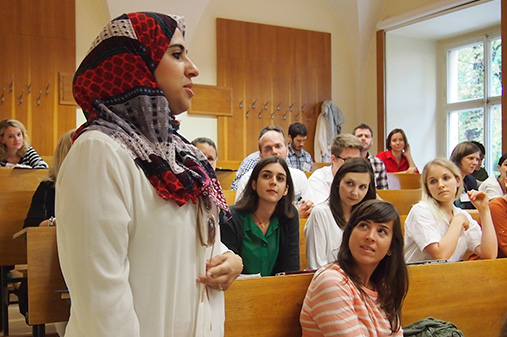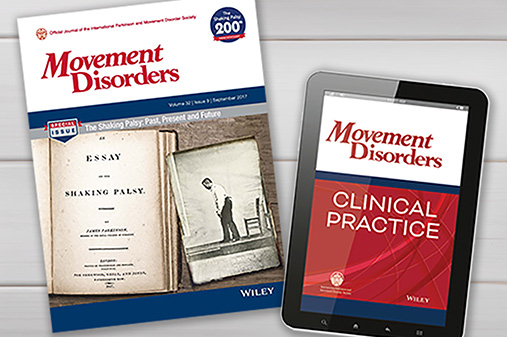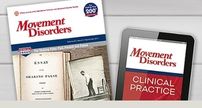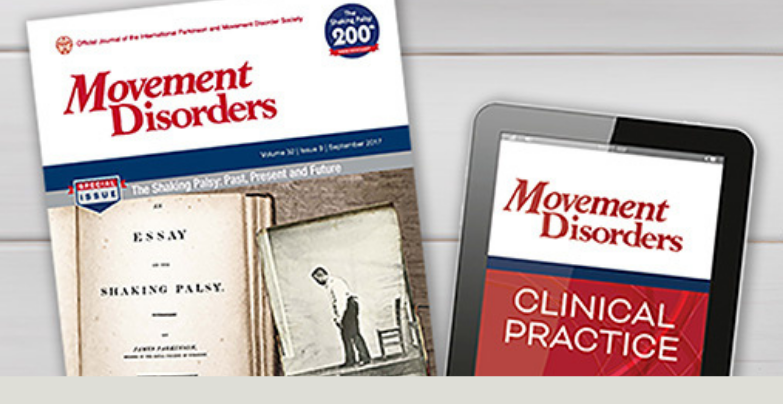
Courses
Advance your knowledge in engaging, interactive courses developed and taught by leaders in the field.
Course Types
Browse All MDS Courses
New courses are added regularly.
Sign up for email notifications »
Journal CME 40.07: Intraputaminal Delivery of Adeno-Associated Virus Serotype 2–Glial Cell Line–Derived Neurotrophic Factor in Mild or Moderate Parkinson’s Disease
On Demand
Journal CME
60 Minutes
Foundational / Beginner
1002 <p>The Journal CME 40.07 article aims to assess safety and preliminary clinical outcomes of optimized bilateral intraputaminal infusion of<br />a single, higher dose of AAV2-GDNF (product code AB-1005) for PD after 18 months.</p> Amber D. Van Laar, MD 60 1.00 https://education.movementdisorders.org/Detail/1002/Journal-CME-40-07:-Intraputaminal-Delivery-of-Adeno-Associated-Virus-Serotype-2–Glial-Cell-Line–Derived-Neurotrophic-Factor-in-Mild-or-Moderate-Parkinson’s-Disease https://education.movementdisorders.org/Upload/ActivityImages/Journal-CME562837664663.jpg 2025-06-25T00:00:00 2026-06-25T00:00:00 <p><strong>ACCREDITATION STATEMENT</strong></p><p>This activity has been planned and implemented in accordance with the accreditation requirements and policies of the Accreditation Council for Continuing Medical Education (ACCME). The International Parkinson and Movement Disorder Society is accredited by the ACCME to provide continuing medical education for physicians.</p><p><br></p><p><strong>CREDIT DESIGNATION STATEMENT</strong></p><p>The International Parkinson and Movement Disorder Society designates this activity for a maximum of 1 <em>AMA PRA Category 1 Credits™</em>. Physicians should only claim credit commensurate with the extent of their participation.</p><p><br></p><p><strong>FACULTY DISCLOSURE</strong></p><p>All individuals in control of content for this activity are required to disclose all financial relationships with ineligible companies (as defined by the ACCME) over the last 24 months. Disclosure information is available <a href="https://d1t84l7yt030ad.cloudfront.net/FroalaFiles/Journal%20CME%2040.07%20-%20Disclosures_24062025111321.pdf" rel="noopener noreferrer" target="_blank">HERE</a>. All relevant financial relationships have been mitigated in advance of this program.</p><p><br></p><p><strong>METHOD OF PARTICIPATION</strong></p><p>Each module will take approximately one (1) hour to complete. Upon reading the article, participants will take a post-test and must receive a grade of 75% or higher to pass. Participants are allowed multiple attempts to complete the post-test. Once the post-test is passed, participants are required to complete the module evaluation.</p><p><br></p><p><strong>SATISFACTORY COMPLETION</strong></p><p>Participants must complete an evaluation for each session they attend to receive continuing medical education credit. Your chosen session(s) must be attended in their entirety. Partial credit for individual sessions is not available.</p><p><br></p><p><strong>CONTENT VALIDITY STATEMENT</strong></p><p>All recommendations involving clinical medicine in MDS activities are based on evidence that is accepted within the profession of medicine as adequate justification for their indications and contraindications in the case of patients. All scientific research referred to, reported or used in CME in support or justification of a patient care recommendations conforms to the generally accepted standards of experimental design, data collection and analysis. Activities that promote recommendations, treatment or manners of practicing medicine not within the definition of CME or are knowing to have risks or dangers that outweigh the benefits or are knowing to be ineffective in the treatment of patients do not constitute valid CME.</p> MDS Education <p><strong>COURSE PURPOSE</strong></p><p>Journal CME highlights various articles covering relevant issues, developments and research topics in the area of movement disorders. Articles are selected from Movement Disorders, the official Journal of the International Parkinson and Movement Disorder Society.</p><p><br></p><p><strong>LEARNING OBJECTIVES</strong></p><p>Upon completion of this activity, learners will be able to:</p><ol><li>Assess the safety and tolerability of AAV2-GDNF gene therapy</li><li>Understand early motor and nonmotor clinical outcomes following gene therapy</li><li>Evaluate the impact of infusion technique and putaminal coverage on therapeutic outcomes</li></ol><p><br></p><p><strong>INTENDED AUDIENCE</strong></p><p>This activity is intended for clinicians, other health professionals, researchers, policy makers from throughout the world, both MDS members and non-members, who interact with patients living with Movement Disorders.</p><p><br></p><p><strong>HARDWARE AND SOFTWARE REQUIREMENTS</strong></p><p>1. Active Internet connection (DSL or Cable). Dial-up connection will have constant buffering problem.</p><p>2. Compatible with Windows PC and MAC (256 MB of RAM or higher).</p><p>3. Activity is best viewed on Internet Explorer 9.0 or higher, Safari 5.0 or higher and Firefox 29.0 or higher.</p><p>4. Adobe Flash Player 12.0 (or higher).</p><p>5. Adobe Reader to print certificate.</p> 0 /Courses/Journal-CME-40.07-Intraputaminal-Delivery-of-Adeno-Associated-Virus-Serotype-2Glial-Cell-LineDerived-Neurotrophic-Factor-in-Mild-or-Moderate-Parkinsons-Disease.htm Journal CME 40.07: Intraputaminal Delivery of Adeno-Associated Virus Serotype 2–Glial Cell Line–Derived Neurotrophic Factor in Mild or Moderate Parkinson’s Disease Journal CME 40.07 2025-07-01T15:01:03.213 0 0 Foundational / Beginner Clinician Fellow Industry Researcher Resident Student Journal CME CME On-Demand English USA
Journal CME 40.06: Long-Term Outcomes on Pallidal Neurostimulation for Dystonia: A Controlled, Prospective 10-Year Follow-Up
On Demand
Journal CME
60 Minutes
Foundational / Beginner
1001 <p>The Journal CME 40.06 article aims to evaluate long-term efficacy and safety of pallidal neurostimulation in patients with isolated generalized or segmental dystonia.</p> Patricia Krause, MD 60 1.00 https://education.movementdisorders.org/Detail/1001/Journal-CME-40-06:-Long-Term-Outcomes-on-Pallidal-Neurostimulation-for-Dystonia:-A-Controlled,-Prospective-10-Year-Follow-Up https://education.movementdisorders.org/Upload/ActivityImages/Journal-CME562837664663.jpg 2025-06-19T00:00:00 2026-06-19T00:00:00 <p><strong>ACCREDITATION STATEMENT</strong></p><p>This activity has been planned and implemented in accordance with the accreditation requirements and policies of the Accreditation Council for Continuing Medical Education (ACCME). The International Parkinson and Movement Disorder Society is accredited by the ACCME to provide continuing medical education for physicians.</p><p><br></p><p><strong>CREDIT DESIGNATION STATEMENT</strong></p><p>The International Parkinson and Movement Disorder Society designates this activity for a maximum of 1 <em>AMA PRA Category 1 Credits™</em>. Physicians should only claim credit commensurate with the extent of their participation.</p><p><br></p><p><strong>FACULTY DISCLOSURE</strong></p><p>All individuals in control of content for this activity are required to disclose all financial relationships with ineligible companies (as defined by the ACCME) over the last 24 months. Disclosure information is available <a href="https://d1t84l7yt030ad.cloudfront.net/FroalaFiles/Journal%20CME%2040.06%20-%20Disclosures_18062025104206.pdf" rel="noopener noreferrer" target="_blank">HERE</a>. All relevant financial relationships have been mitigated in advance of this program.</p><p><br></p><p><strong>METHOD OF PARTICIPATION</strong></p><p>Each module will take approximately one (1) hour to complete. Upon reading the article, participants will take a post-test and must receive a grade of 75% or higher to pass. Participants are allowed multiple attempts to complete the post-test. Once the post-test is passed, participants are required to complete the module evaluation.</p><p><br></p><p><strong>SATISFACTORY COMPLETION</strong></p><p>Participants must complete an evaluation for each session they attend to receive continuing medical education credit. Your chosen session(s) must be attended in their entirety. Partial credit for individual sessions is not available.</p><p><br></p><p><strong>CONTENT VALIDITY STATEMENT</strong></p><p>All recommendations involving clinical medicine in MDS activities are based on evidence that is accepted within the profession of medicine as adequate justification for their indications and contraindications in the case of patients. All scientific research referred to, reported or used in CME in support or justification of a patient care recommendations conforms to the generally accepted standards of experimental design, data collection and analysis. Activities that promote recommendations, treatment or manners of practicing medicine not within the definition of CME or are knowing to have risks or dangers that outweigh the benefits or are knowing to be ineffective in the treatment of patients do not constitute valid CME.</p> MDS Education <p><strong>COURSE PURPOSE</strong></p><p>Journal CME highlights various articles covering relevant issues, developments and research topics in the area of movement disorders. Articles are selected from Movement Disorders, the official Journal of the International Parkinson and Movement Disorder Society.</p><p><br></p><p><strong>LEARNING OBJECTIVES</strong></p><p>Upon completion of this activity, learners will be able to:</p><p>1. Evaluate the long-term efficacy of pallidal neurostimulation</p><p>2. Analyze the safety and psychosocial outcomes of pallidal neurostimulation</p><p>3. Identify predictors and causes of DBS treatment failure</p><p><br></p><p><strong>INTENDED AUDIENCE</strong></p><p>This activity is intended for clinicians, other health professionals, researchers, policy makers from throughout the world, both MDS members and non-members, who interact with patients living with Movement Disorders.</p><p><br></p><p><strong>HARDWARE AND SOFTWARE REQUIREMENTS</strong></p><p>1. Active Internet connection (DSL or Cable). Dial-up connection will have constant buffering problem.</p><p>2. Compatible with Windows PC and MAC (256 MB of RAM or higher).</p><p>3. Activity is best viewed on Internet Explorer 9.0 or higher, Safari 5.0 or higher and Firefox 29.0 or higher.</p><p>4. Adobe Flash Player 12.0 (or higher).</p><p>5. Adobe Reader to print certificate.</p> 0 /Courses/Journal-CME-40.06-Long-Term-Outcomes-on-Pallidal-Neurostimulation-for-Dystonia-A-Controlled-Prospective-10-Year-Follow-Up.htm Journal CME 40.06: Long-Term Outcomes on Pallidal Neurostimulation for Dystonia: A Controlled, Prospective 10-Year Follow-Up Journal CME 40.06 2025-07-01T15:01:01.590 0 0 Foundational / Beginner Clinician Fellow Industry Researcher Resident Student Journal CME CME On-Demand English USA
MDS Case Presentation: GLUT1 Deficiency
On Demand
Case Presentation Series
15 Minutes
Foundational / Beginner
940 This brief 15 minute case presentation will provide the learner with an opportunity to accept the role of a decisive clinician regarding a clinical case of a patient with GLUT1 deficiency. Antonella Macerollo, MD, PhD, Dean Walton, MD, Michael Bonello, MD, FRCP, MSc 15 0.00 https://education.movementdisorders.org/Detail/940/MDS-Case-Presentation:-GLUT1-Deficiency https://education.movementdisorders.org/Upload/ActivityImages/Case-based-Series866197.jpg https://education.movementdisorders.org/Upload/BannerImages/casepres690182.jpg 2025-06-16T00:00:00 2028-06-16T00:00:00 MDS Education <p><strong>FACULTY</strong></p><p>Antonella Macerollo, MD, PhD - The Walton Centre NHS Foundation Trust, Liverpool, United Kingdom</p><p>Dean Walton, MD - The Walton Centre NHS Foundation Trust, Liverpool, United Kingdom</p><p>Michael Bonello, MD, FRCP, MSc - The Walton Centre NHS Foundation Trust, Liverpool, United Kingdom</p><p><br></p><p><strong>LEARNING OBJECTIVES</strong></p><p>Upon completion of this activity, learners will be able to:</p><p>1. Develop a step-by-step diagnostic approach to a wide spectrum of movement disorders based on clinical history, phenomenology and investigation findings.</p><p><br></p><p><strong>INTENDED AUDIENCE</strong></p><p>This activity is intended for clinicians, other health professionals, researchers, policy makers from throughout the world, both MDS members and non-members, who interact with patients living with Movement Disorders.</p><p><br></p><p><strong>HARDWARE AND SOFTWARE REQUIREMENTS</strong></p><p>1. Active Internet connection (DSL or Cable). Dial-up connection will have constant buffering problem.</p><p>2. Compatible with Windows PC and MAC (256 MB of RAM or higher).</p><p>3. Activity is best viewed on Internet Explorer 9.0 or higher, Safari 5.0 or higher and Firefox 29.0 or higher.</p><p>4. Adobe Flash Player 12.0 (or higher).</p><p>5. Adobe Reader to print certificate.</p> 0 /Courses/MDS-Case-Presentation-GLUT1-Deficiency.htm MDS Case Presentation: GLUT1 Deficiency 2025-06-16T09:00:53.447 0 0 Foundational / Beginner Clinician Clinician-Primary Care Fellow Health Professional Industry Resident Student Case Presentation Series On-Demand English USA
Journal CME 40.05: Artificial Intelligence-Based Virtual Assistant for the Diagnostic Approach of Chronic Ataxias
On Demand
Journal CME
60 Minutes
Foundational / Beginner
992 <p>The Journal CME 40.05 article aims to develop and validate an AI powered virtual assistant for diagnosing chronic ataxias.</p> Lucas Alessandro, MD 60 1.00 2025-05-21 https://education.movementdisorders.org/Detail/992/Journal-CME-40-05:-Artificial-Intelligence-Based-Virtual-Assistant-for-the-Diagnostic-Approach-of-Chronic-Ataxias https://education.movementdisorders.org/Upload/ActivityImages/Journal-CME562837664663.jpg 2025-05-21T00:00:00 2026-05-21T00:00:00 <p><strong>ACCREDITATION STATEMENT</strong></p><p>This activity has been planned and implemented in accordance with the accreditation requirements and policies of the Accreditation Council for Continuing Medical Education (ACCME). The International Parkinson and Movement Disorder Society is accredited by the ACCME to provide continuing medical education for physicians.</p><p><br></p><p><strong>CREDIT DESIGNATION STATEMENT</strong></p><p>The International Parkinson and Movement Disorder Society designates this activity for a maximum of 1 <em>AMA PRA Category 1 Credits™</em>. Physicians should only claim credit commensurate with the extent of their participation.</p><p><br></p><p><strong>FACULTY DISCLOSURE</strong></p><p>All individuals in control of content for this activity are required to disclose all financial relationships with ineligible companies (as defined by the ACCME) over the last 24 months. Disclosure information is available <a href="https://d1t84l7yt030ad.cloudfront.net/FroalaFiles/Journal%20CME%2040.05%20-%20Disclosures_20052025015905.pdf" rel="noopener noreferrer" target="_blank">HERE</a>. All relevant financial relationships have been mitigated in advance of this program.</p><p><br></p><p><strong>METHOD OF PARTICIPATION</strong></p><p>Each module will take approximately one (1) hour to complete. Upon reading the article, participants will take a post-test and must receive a grade of 75% or higher to pass. Participants are allowed multiple attempts to complete the post-test. Once the post-test is passed, participants are required to complete the module evaluation.</p><p><br></p><p><strong>SATISFACTORY COMPLETION</strong></p><p>Participants must complete an evaluation for each session they attend to receive continuing medical education credit. Your chosen session(s) must be attended in their entirety. Partial credit for individual sessions is not available.</p><p><br></p><p><strong>CONTENT VALIDITY STATEMENT</strong></p><p>All recommendations involving clinical medicine in MDS activities are based on evidence that is accepted within the profession of medicine as adequate justification for their indications and contraindications in the case of patients. All scientific research referred to, reported or used in CME in support or justification of a patient care recommendations conforms to the generally accepted standards of experimental design, data collection and analysis. Activities that promote recommendations, treatment or manners of practicing medicine not within the definition of CME or are knowing to have risks or dangers that outweigh the benefits or are knowing to be ineffective in the treatment of patients do not constitute valid CME.</p> MDS Education <p><strong>COURSE PURPOSE</strong><br>Journal CME highlights various articles covering relevant issues, developments and research topics in the area of movement disorders. Articles are selected from Movement Disorders, the official Journal of the International Parkinson and Movement Disorder Society.<br><br><strong>LEARNING OBJECTIVES</strong><br>Upon completion of this activity, learners will be able to:<br>1. Understand the diagnostic challenges associated with chronic ataxias due to their clinical and genetic heterogeneity<br>2. Assess how AI can improve diagnostic accuracy and efficiency for chronic ataxias<br>3. Evaluate the performance of the AI-based virtual assistant in diagnosing chronic ataxias<br><br><strong>INTENDED AUDIENCE</strong><br>This activity is intended for clinicians, other health professionals, researchers, policy makers from throughout the world, both MDS members and non-members, who interact with patients living with Movement Disorders.<br><br><strong>HARDWARE AND SOFTWARE REQUIREMENTS</strong><br>1. Active Internet connection (DSL or Cable). Dial-up connection will have constant buffering problem.<br>2. Compatible with Windows PC and MAC (256 MB of RAM or higher).<br>3. Activity is best viewed on Internet Explorer 9.0 or higher, Safari 5.0 or higher and Firefox 29.0 or higher.<br>4. Adobe Flash Player 12.0 (or higher).<br>5. Adobe Reader to print certificate.<br><br><br></p> 0 /Courses/Journal-CME-40.05-Artificial-Intelligence-Based-Virtual-Assistant-for-the-Diagnostic-Approach-of-Chronic-Ataxias.htm Journal CME 40.05: Artificial Intelligence-Based Virtual Assistant for the Diagnostic Approach of Chronic Ataxias Journal CME 40.05 2025-05-27T18:00:56.423 0 0 Foundational / Beginner Clinician Industry Researcher Resident Student Journal CME CME On-Demand English USA
MDS Case Presentation: A 32 Year-Old Woman with Tremor
On Demand
Case Presentation Series
15 Minutes
Foundational / Beginner
939 This brief 15 minute case presentation will provide the learner with an opportunity to accept the role of a decisive clinician regarding a clinical case of a 32 year-old patient with tremor. Gabriel Arango, MD 15 0.00 2025-05-19 https://education.movementdisorders.org/Detail/939/MDS-Case-Presentation:-A-32-Year-Old-Woman-with-Tremor https://education.movementdisorders.org/Upload/ActivityImages/Case-based-Series866197.jpg 2025-05-19T00:00:00 2028-05-19T00:00:00 MDS Education <p><strong>FACULTY</strong></p><p>Gabriel Arango, MD - Clinica De Marly, Instituto Latinoamericano de Neurología y Sistema Nervioso, Bogota, Colombia</p><p><br></p><p><strong>LEARNING OBJECTIVES</strong></p><p>Upon completion of this activity, learners will be able to:</p><p>1. Develop a step-by-step diagnostic approach to a wide spectrum of movement disorders based on clinical history, phenomenology and investigation findings.</p><p><br></p><p><strong>INTENDED AUDIENCE</strong></p><p>This activity is intended for clinicians, other health professionals, researchers, policy makers from throughout the world, both MDS members and non-members, who interact with patients living with Movement Disorders.</p><p><br></p><p><strong>HARDWARE AND SOFTWARE REQUIREMENTS</strong></p><p>1. Active Internet connection (DSL or Cable). Dial-up connection will have constant buffering problem.</p><p>2. Compatible with Windows PC and MAC (256 MB of RAM or higher).</p><p>3. Activity is best viewed on Internet Explorer 9.0 or higher, Safari 5.0 or higher and Firefox 29.0 or higher.</p><p>4. Adobe Flash Player 12.0 (or higher).</p><p>5. Adobe Reader to print certificate.</p> 0 /Courses/MDS-Case-Presentation-A-32-Year-Old-Woman-with-Tremor.htm MDS Case Presentation: A 32 Year-Old Woman with Tremor 2025-05-19T12:00:58.020 0 0 Foundational / Beginner Clinician Clinician-Primary Care Fellow Health Professional Industry Resident Student Case Presentation Series On-Demand English USA
Journal CME 40.04: Human Endogenous Retrovirus K in Astrocytes Is Altered in Parkinson’s Disease
On Demand
Journal CME
60 Minutes
Foundational / Beginner, Experienced / Intermediate
979 <p>The Journal CME 40.04 article aims to unravel the pathological relationship between human endogenous retrovirus K (HERV-K) and PD, determine the localization of HERV-K in the brain, determine whether HERV-K levels are altered in PD brain and blood, and examine whether HERV-K could serve as a biomarker for PD.</p> YuHong Fu, PhD 60 1.00 2025-05-05 https://education.movementdisorders.org/Detail/979/Journal-CME-40-04:-Human-Endogenous-Retrovirus-K-in-Astrocytes-Is-Altered-in-Parkinson’s-Disease https://education.movementdisorders.org/Upload/ActivityImages/Journal-CME562837664663.jpg 2025-05-05T00:00:00 2026-05-05T00:00:00 <p><strong>ACCREDITATION STATEMENT</strong></p><p>This activity has been planned and implemented in accordance with the accreditation requirements and policies of the Accreditation Council for Continuing Medical Education (ACCME). The International Parkinson and Movement Disorder Society is accredited by the ACCME to provide continuing medical education for physicians.</p><p><br></p><p><strong>CREDIT DESIGNATION STATEMENT</strong></p><p>The International Parkinson and Movement Disorder Society designates this activity for a maximum of 1 <em>AMA PRA Category 1 Credits™</em>. Physicians should only claim credit commensurate with the extent of their participation.</p><p><br></p><p><strong>FACULTY DISCLOSURE</strong></p><p>All individuals in control of content for this activity are required to disclose all financial relationships with ineligible companies (as defined by the ACCME) over the last 24 months. Disclosure information is available <a href="https://d1t84l7yt030ad.cloudfront.net/FroalaFiles/Journal%20CME%2040.04%20-%20Disclosures_02052025032439.pdf" rel="noopener noreferrer" target="_blank">HERE</a>. All relevant financial relationships have been mitigated in advance of this program.</p><p><br></p><p><strong>METHOD OF PARTICIPATION</strong></p><p>Each module will take approximately one (1) hour to complete. Upon reading the article, participants will take a post-test and must receive a grade of 75% or higher to pass. Participants are allowed multiple attempts to complete the post-test. Once the post-test is passed, participants are required to complete the module evaluation.</p><p><br></p><p><strong>SATISFACTORY COMPLETION</strong></p><p>Participants must complete an evaluation for each session they attend to receive continuing medical education credit. Your chosen session(s) must be attended in their entirety. Partial credit for individual sessions is not available.</p><p><br></p><p><strong>CONTENT VALIDITY STATEMENT</strong></p><p>All recommendations involving clinical medicine in MDS activities are based on evidence that is accepted within the profession of medicine as adequate justification for their indications and contraindications in the case of patients. All scientific research referred to, reported or used in CME in support or justification of a patient care recommendations conforms to the generally accepted standards of experimental design, data collection and analysis. Activities that promote recommendations, treatment or manners of practicing medicine not within the definition of CME or are knowing to have risks or dangers that outweigh the benefits or are knowing to be ineffective in the treatment of patients do not constitute valid CME.</p> MDS Education <p><strong>COURSE PURPOSE</strong></p><p>Journal CME highlights various articles covering relevant issues, developments and research topics in the area of movement disorders. Articles are selected from Movement Disorders, the official Journal of the International Parkinson and Movement Disorder Society.</p><p><br></p><p><strong>LEARNING OBJECTIVES</strong></p><p>Upon completion of this activity, learners will be able to:</p><p>1. Understand the potential pathological role of HERV-K in Parkinson’s disease (PD)</p><p>2. Identify the localization of HERV-K expression in the brain in relation to PD</p><p>3. Evaluate the potential of HERV-K as a biomarker through its expression levels in PD brain and blood</p><p><br></p><p><strong>INTENDED AUDIENCE</strong></p><p>This activity is intended for clinicians, other health professionals, researchers, policy makers from throughout the world, both MDS members and non-members, who interact with patients living with Movement Disorders.</p><p><br></p><p><strong>HARDWARE AND SOFTWARE REQUIREMENTS</strong></p><p>1. Active Internet connection (DSL or Cable). Dial-up connection will have constant buffering problem.</p><p>2. Compatible with Windows PC and MAC (256 MB of RAM or higher).</p><p>3. Activity is best viewed on Internet Explorer 9.0 or higher, Safari 5.0 or higher and Firefox 29.0 or higher.</p><p>4. Adobe Flash Player 12.0 (or higher).</p><p>5. Adobe Reader to print certificate.</p> 0 /Courses/Journal-CME-40.04-Human-Endogenous-Retrovirus-K-in-Astrocytes-Is-Altered-in-Parkinsons-Disease.htm Journal CME 40.04: Human Endogenous Retrovirus K in Astrocytes Is Altered in Parkinson’s Disease Journal CME 40.04 2025-05-05T09:01:00.803 0 0 Foundational / Beginner Experienced / Intermediate Clinician Industry Researcher Resident Student Journal CME CME On-Demand English USA
Journal CME 40.03: Mitochondrial DNA Copy Number as a Potential Biomarker for the Severity of Motor Symptoms and Prognosis in Parkinson’s Disease
On Demand
Journal CME
60 Minutes
Foundational / Beginner
950 <p>The Journal CME 40.03 article provides a study to assess the diagnostic and prognostic capabilities of mtDNA-CN in PD.</p> Sungyang Jo, MD, PhD 60 1.00 2025-03-03 https://education.movementdisorders.org/Detail/950/Journal-CME-40-03:-Mitochondrial-DNA-Copy-Number-as-a-Potential-Biomarker-for-the-Severity-of-Motor-Symptoms-and-Prognosis-in-Parkinson’s-Disease https://education.movementdisorders.org/Upload/ActivityImages/Journal-CME562837664663.jpg 2025-03-03T00:00:00 2026-03-03T00:00:00 <p><strong>ACCREDITATION STATEMENT</strong></p><p>This activity has been planned and implemented in accordance with the accreditation requirements and policies of the Accreditation Council for Continuing Medical Education (ACCME). The International Parkinson and Movement Disorder Society is accredited by the ACCME to provide continuing medical education for physicians.</p><p><br></p><p><strong>CREDIT DESIGNATION STATEMENT</strong></p><p>The International Parkinson and Movement Disorder Society designates this activity for a maximum of 1 <em>AMA PRA Category 1 Credits™</em>. Physicians should only claim credit commensurate with the extent of their participation.</p><p><br></p><p><strong>FACULTY DISCLOSURE</strong></p><p>All individuals in control of content for this activity are required to disclose all financial relationships with ineligible companies (as defined by the ACCME) over the last 24 months. Disclosure information is available <a href="https://d1t84l7yt030ad.cloudfront.net/FroalaFiles/Journal%20CME%2040.03%20-%20Disclosures_21032025112928.pdf" rel="noopener noreferrer" target="_blank">HERE</a>. All relevant financial relationships have been mitigated in advance of this program.</p><p><br></p><p><strong>METHOD OF PARTICIPATION</strong></p><p>Each module will take approximately one (1) hour to complete. Upon reading the article, participants will take a post-test and must receive a grade of 75% or higher to pass. Participants are allowed multiple attempts to complete the post-test. Once the post-test is passed, participants are required to complete the module evaluation.</p><p><br></p><p><strong>SATISFACTORY COMPLETION</strong></p><p>Participants must complete an evaluation for each session they attend to receive continuing medical education credit. Your chosen session(s) must be attended in their entirety. Partial credit for individual sessions is not available.</p><p><br></p><p><strong>CONTENT VALIDITY STATEMENT</strong></p><p>All recommendations involving clinical medicine in MDS activities are based on evidence that is accepted within the profession of medicine as adequate justification for their indications and contraindications in the case of patients. All scientific research referred to, reported or used in CME in support or justification of a patient care recommendations conforms to the generally accepted standards of experimental design, data collection and analysis. Activities that promote recommendations, treatment or manners of practicing medicine not within the definition of CME or are knowing to have risks or dangers that outweigh the benefits or are knowing to be ineffective in the treatment of patients do not constitute valid CME.</p> MDS Education <p><strong>COURSE PURPOSE</strong></p><p>Journal CME highlights various articles covering relevant issues, developments and research topics in the area of movement disorders. Articles are selected from Movement Disorders, the official Journal of the International Parkinson and Movement Disorder Society.</p><p><br></p><p><strong>LEARNING OBJECTIVES</strong></p><p>Upon completion of this activity, learners will be able to:</p><p>1. Understand the importance of the necessity for accurate and cost-effective prognostic biomarkers</p><p>2. Assess the use of prognostic biomarkers as crucial for patient risk stratification, providing potential applicability in both clinical settings and research trials</p><p>3. Evaluate how blood mtDNA-CN may function as a diagnostic biomarker for PD and a prognostic marker for dementia in patients with PD</p><p><br></p><p><strong>INTENDED AUDIENCE</strong></p><p>This activity is intended for clinicians, other health professionals, researchers, policy makers from throughout the world, both MDS members and non-members, who interact with patients living with Movement Disorders.</p><p><br></p><p><strong>HARDWARE AND SOFTWARE REQUIREMENTS</strong></p><p>1. Active Internet connection (DSL or Cable). Dial-up connection will have constant buffering problem.</p><p>2. Compatible with Windows PC and MAC (256 MB of RAM or higher).</p><p>3. Activity is best viewed on Internet Explorer 9.0 or higher, Safari 5.0 or higher and Firefox 29.0 or higher.</p><p>4. Adobe Flash Player 12.0 (or higher).</p><p>5. Adobe Reader to print certificate.</p> 0 /Courses/Journal-CME-40.03-Mitochondrial-DNA-Copy-Number-as-a-Potential-Biomarker-for-the-Severity-of-Motor-Symptoms-and-Prognosis-in-Parkinsons-Disease.htm Journal CME 40.03: Mitochondrial DNA Copy Number as a Potential Biomarker for the Severity of Motor Symptoms and Prognosis in Parkinson’s Disease Journal CME 40.03 2025-03-25T12:00:55.470 0 0 Foundational / Beginner Clinician Industry Researcher Resident Student Journal CME CME On-Demand English USA
Approach and Management of Neuropsychiatric Issues in Parkinson’s Disease
On Demand
Interactive
60 Minutes
Foundational / Beginner
919 This module will provide up-to-date knowledge of key neuropsychiatric features of movement disorders including practical guidelines, assessment tools for diagnosis and evidence-based treatments. Additionally, the module will discuss state-of-the-art care for the complex needs of our patients with movement disorders. Lana Chahine, MD; Daniel Weintraub, MD; Bart Swinnen, MD, PhD 60 1.00 2025-03-17 https://education.movementdisorders.org/Detail/919/Approach-and-Management-of-Neuropsychiatric-Issues-in-Parkinson’s-Disease https://education.movementdisorders.org/Upload/ActivityImages/05INTERACT-41-001-Neuropsychiatric-Issues-in-PD-202x108821930.jpg 2025-03-17T00:00:00 2028-03-17T00:00:00 <p><strong>ACCREDITATION STATEMENT</strong></p><p>This activity has been planned and implemented in accordance with the accreditation requirements and policies of the Accreditation Council for Continuing Medical Education (ACCME). The International Parkinson and Movement Disorder Society is accredited by the ACCME to provide continuing medical education for physicians.</p><p><br></p><p><strong>CREDIT DESIGNATION STATEMENT</strong></p><p>The International Parkinson and Movement Disorder Society designates this activity for a maximum of 1 <em>AMA PRA Category 1 Credits™</em>. Physicians should only claim credit commensurate with the extent of their participation.</p><p><br></p><p><strong>FACULTY DISCLOSURE</strong></p><p>All individuals in control of content for this activity are required to disclose all financial relationships with ineligible companies (as defined by the ACCME) over the last 24 months. Disclosure information is available <a class="fr-file" href="https://d1t84l7yt030ad.cloudfront.net/FroalaFiles/Disclosures - Neuropsychiatric Issues in PD_03032025030439.pdf" target="_blank">HERE</a>. All relevant financial relationships have been mitigated in advance of this program.</p><p><br></p><p><strong>SATISFACTORY COMPLETION</strong></p><p>Participants must complete an evaluation for each session they attend to receive continuing medical education credit. Your chosen session(s) must be attended in their entirety. Partial credit for individual sessions is not available.</p><p><br></p><p><strong>METHOD OF PARTICIPATION </strong></p><p>Your chosen sessions must be attended in their entirety. Partial credit of individual sessions is not available. If you are seeking continuing education credit for a specialty not listed in the Accreditation Statement, it is your responsibility to contact your licensing/certification board to determine course eligibility for your board requirement.</p><p><br></p><p><strong>CONTENT VALIDITY STATEMENT</strong></p><p>All recommendations involving clinical medicine in MDS activities are based on evidence that is accepted within the profession of medicine as adequate justification for their indications and contraindications in the case of patients. All scientific research referred to, reported or used in CME in support or justification of a patient care recommendations conforms to the generally accepted standards of experimental design, data collection and analysis. Activities that promote recommendations, treatment or manners of practicing medicine not within the definition of CME or are knowing to have risks or dangers that outweigh the benefits or are knowing to be ineffective in the treatment of patients do not constitute valid CME.</p> MDS Education <p><span style="background-color: null;"><strong>FACULTY</strong></span></p><p>Lana Chahine, MD - University of Pittsburgh, Pittsburgh, PA, USA</p><p>Daniel Weintraub, MD - University of Pennsylvania, Philadelphia, PA, USA</p><p>Bart Swinnen, MD, PhD - UCSF, San Francisco, CA, USA</p><p><br></p><p><strong>LEARNING OBJECTIVES</strong></p><p>Upon completion of this activity, learners will be able to: </p><p>1. Recognize the range of key neuropsychiatric features of movement disorders.</p><p>2. Learn how to assess and diagnose neuropsychiatric disorders in movement disorders.</p><p>3. Implement an evidence-based treatment plan for neuropsychiatric features of movement disorders.</p><p><br></p><p><strong>INTENDED AUDIENCE</strong></p><p>This activity is intended for students, residents, primary care providers, internists, allied health, non-neurology specialists, and industry who have limited to no movement disorder experience.</p><p><br></p><p><strong>HARDWARE AND SOFTWARE REQUIREMENTS</strong></p><p>1. Active Internet connection (DSL or Cable). Dial-up connection will have constant buffering problem.</p><p>2. Compatible with Windows PC and MAC (256 MB of RAM or higher).</p><p>3. Activity is best viewed on Internet Explorer 9.0 or higher, Safari 5.0 or higher and Firefox 29.0 or higher.</p><p>4. Adobe Flash Player 12.0 (or higher).</p><p>5. Adobe Reader to print certificate.</p> 0 /Courses/Approach-and-Management-of-Neuropsychiatric-Issues-in-Parkinsons-Disease.htm Approach and Management of Neuropsychiatric Issues in Parkinson’s Disease 2025-03-17T00:01:37.670 0 0 Foundational / Beginner Clinician Fellow Industry Resident Student Interactive CME On-Demand English USA
Journal CME 40.02: All-Cause and Cause-Specific Mortality in Tourette Syndrome and Chronic Tic Disorder
On Demand
Journal CME
60 Minutes
Experienced / Intermediate
925 <p>The Journal CME 40.02 article provides a study to estimate the risk of all-cause and cause-specific mortality in individuals with Tourette syndrome/chronic tic disorder compared with unaffected matched individuals and unaffected full siblings.</p> Lorena Fernandez de la Cruz, PhD 60 1.00 2025-02-28 https://education.movementdisorders.org/Detail/925/Journal-CME-40-02:-All-Cause-and-Cause-Specific-Mortality-in-Tourette-Syndrome-and-Chronic-Tic-Disorder https://education.movementdisorders.org/Upload/ActivityImages/Journal-CME562837664663.jpg 2025-02-28T00:00:00 2026-02-28T00:00:00 <p><strong>ACCREDITATION STATEMENT</strong></p><p>This activity has been planned and implemented in accordance with the accreditation requirements and policies of the Accreditation Council for Continuing Medical Education (ACCME). The International Parkinson and Movement Disorder Society is accredited by the ACCME to provide continuing medical education for physicians.</p><p><br></p><p><strong>CREDIT DESIGNATION STATEMENT</strong></p><p>The International Parkinson and Movement Disorder Society designates this activity for a maximum of 1 <em>AMA PRA Category 1 Credits™</em>. Physicians should only claim credit commensurate with the extent of their participation.</p><p><br></p><p><strong>FACULTY DISCLOSURE</strong></p><p>All individuals in control of content for this activity are required to disclose all financial relationships with ineligible companies (as defined by the ACCME) over the last 24 months. Disclosure information is available <a class="fr-file" href="https://d1t84l7yt030ad.cloudfront.net/FroalaFiles/Journal CME 40.02 - Disclosures_26022025095412.pdf" target="_blank">HERE</a>. All relevant financial relationships have been mitigated in advance of this program.</p><p><br></p><p><strong>METHOD OF PARTICIPATION</strong></p><p>Each module will take approximately one (1) hour to complete. Upon reading the article, participants will take a post-test and must receive a grade of 75% or higher to pass. Participants are allowed multiple attempts to complete the post-test. Once the post-test is passed, participants are required to complete the module evaluation.</p><p><br></p><p><strong>SATISFACTORY COMPLETION</strong></p><p>Participants must complete an evaluation for each session they attend to receive continuing medical education credit. Your chosen session(s) must be attended in their entirety. Partial credit for individual sessions is not available.</p><p><br></p><p><strong>CONTENT VALIDITY STATEMENT</strong></p><p>All recommendations involving clinical medicine in MDS activities are based on evidence that is accepted within the profession of medicine as adequate justification for their indications and contraindications in the case of patients. All scientific research referred to, reported or used in CME in support or justification of a patient care recommendations conforms to the generally accepted standards of experimental design, data collection and analysis. Activities that promote recommendations, treatment or manners of practicing medicine not within the definition of CME or are knowing to have risks or dangers that outweigh the benefits or are knowing to be ineffective in the treatment of patients do not constitute valid CME.</p> MDS Education <p><strong>COURSE PURPOSE</strong></p><p>Journal CME highlights various articles covering relevant issues, developments and research topics in the area of movement disorders. Articles are selected from Movement Disorders, the official Journal of the International Parkinson and Movement Disorder Society.</p><p><br></p><p><strong>LEARNING OBJECTIVES</strong></p><p>Upon completion of this activity, learners will be able to:</p><p>1. Evaluate the risk of all-cause and cause-specific mortality of individuals with TS/CTD.</p><p>2. Understand the importance of exploring the specific natural causes leading to deaths in this patient group.</p><p>3. Assess the observations of the sibling comparison and relation to familial confounding.</p><p><br></p><p><strong>INTENDED AUDIENCE</strong></p><p>This activity is intended for clinicians, other health professionals, researchers, policy makers from throughout the world, both MDS members and non-members, who interact with patients living with Movement Disorders.</p><p><br></p><p><strong>HARDWARE AND SOFTWARE REQUIREMENTS</strong></p><p>1. Active Internet connection (DSL or Cable). Dial-up connection will have constant buffering problem.</p><p>2. Compatible with Windows PC and MAC (256 MB of RAM or higher).</p><p>3. Activity is best viewed on Internet Explorer 9.0 or higher, Safari 5.0 or higher and Firefox 29.0 or higher.</p><p>4. Adobe Flash Player 12.0 (or higher).</p><p>5. Adobe Reader to print certificate</p> 0 /Courses/Journal-CME-40.02-All-Cause-and-Cause-Specific-Mortality-in-Tourette-Syndrome-and-Chronic-Tic-Disorder.htm Journal CME 40.02: All-Cause and Cause-Specific Mortality in Tourette Syndrome and Chronic Tic Disorder Journal CME 40.02 2025-02-28T00:01:49.403 0 0 Experienced / Intermediate Clinician Industry Researcher Resident Student Journal CME CME On-Demand English USA
MDS Case Presentation: An 18-year-old Patient with an Abnormal Gait and Speech
On Demand
Case Presentation Series
15 Minutes
Foundational / Beginner
765 This brief 15 minute case presentation will provide the learner with an opportunity to accept the role of a decisive clinician regarding a clinical case of an 18-year-old patient with an abnormal gait and speech. Kishore Raj Kumar, MBBS, PhD, FRACP 15 0.00 2025-02-19 https://education.movementdisorders.org/Detail/765/MDS-Case-Presentation:-An-18-year-old-Patient-with-an-Abnormal-Gait-and-Speech https://education.movementdisorders.org/Upload/ActivityImages/Case-based-Series866197.jpg 2025-02-19T00:00:00 2028-02-19T00:00:00 MDS Education <p><strong>FACULTY</strong></p><p>Kishore Raj Kumar, MBBS, PhD, FRACP - The Garvan Institute of Medical Research and Concord Hospital, Sydney, Australia</p><p><br></p><p><strong>LEARNING OBJECTIVES</strong></p><p>Upon completion of this activity, learners will be able to:</p><p>1. Develop a step-by-step diagnostic approach to a wide spectrum of movement disorders based on clinical history, phenomenology and investigation findings.</p><p><br></p><p><strong>INTENDED AUDIENCE</strong></p><p>This activity is intended for clinicians, other health professionals, researchers, policy makers from throughout the world, both MDS members and non-members, who interact with patients living with Movement Disorders.</p><p><br></p><p><strong>HARDWARE AND SOFTWARE REQUIREMENTS</strong></p><p>1. Active Internet connection (DSL or Cable). Dial-up connection will have constant buffering problem.</p><p>2. Compatible with Windows PC and MAC (256 MB of RAM or higher).</p><p>3. Activity is best viewed on Internet Explorer 9.0 or higher, Safari 5.0 or higher and Firefox 29.0 or higher.</p><p>4. Adobe Flash Player 12.0 (or higher).</p><p>5. Adobe Reader to print certificate.</p> 0 /Courses/MDS-Case-Presentation-An-18-year-old-Patient-with-an-Abnormal-Gait-and-Speech.htm MDS Case Presentation: An 18-year-old Patient with an Abnormal Gait and Speech 2025-02-19T18:00:32.067 0 0 Foundational / Beginner Clinician Clinician-Primary Care Fellow Health Professional Industry Resident Student Case Presentation Series On-Demand English USA
Many MDS courses are free or offer need-based assistance. MDS members receive reduced rates.
View each couse's details for rates and available grant opportunities.
Popular Courses

A Comprehensive Review of Movement Disorders for the Clinical Practitioner
"As a rite of passage, every movement disorder fellow must pass through the Aspen course."
“The Aspen Course” has been the foundation for movement disorders education for more than 30 years, providing a broad but in-depth overview of the field's core concepts. Learn from and network alongside the foremost leaders in the field.

School for Young Neurologists
A prestigious opportunity to learn from the foremost experts and gain the knowledge, practical skills, and connections that can shape your career. Offered annually in each region.

















